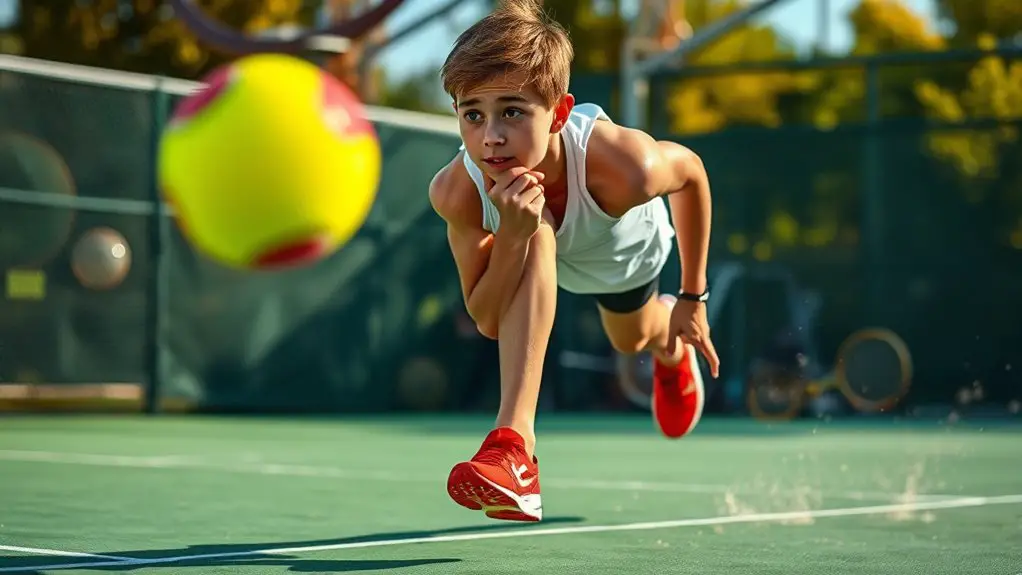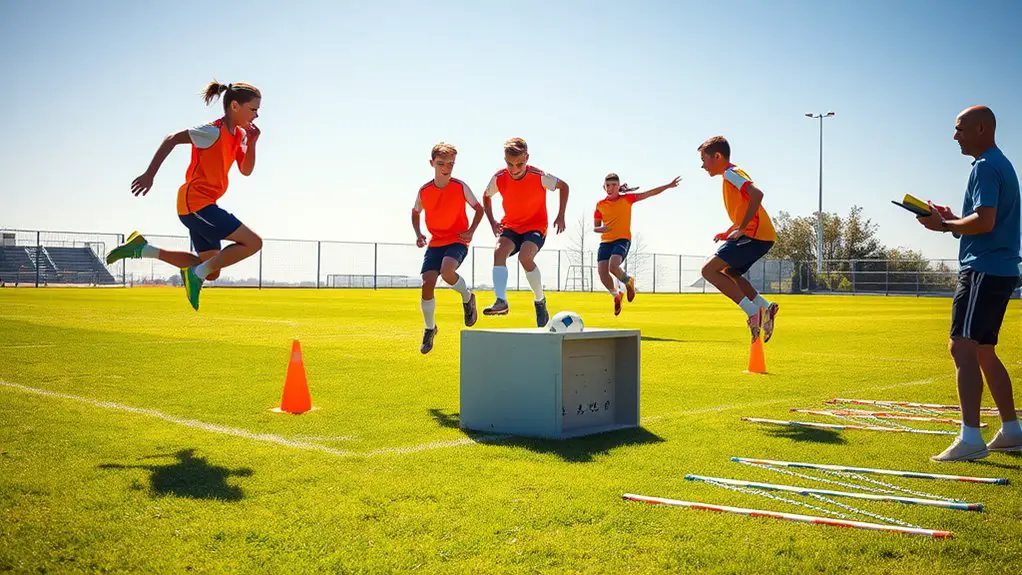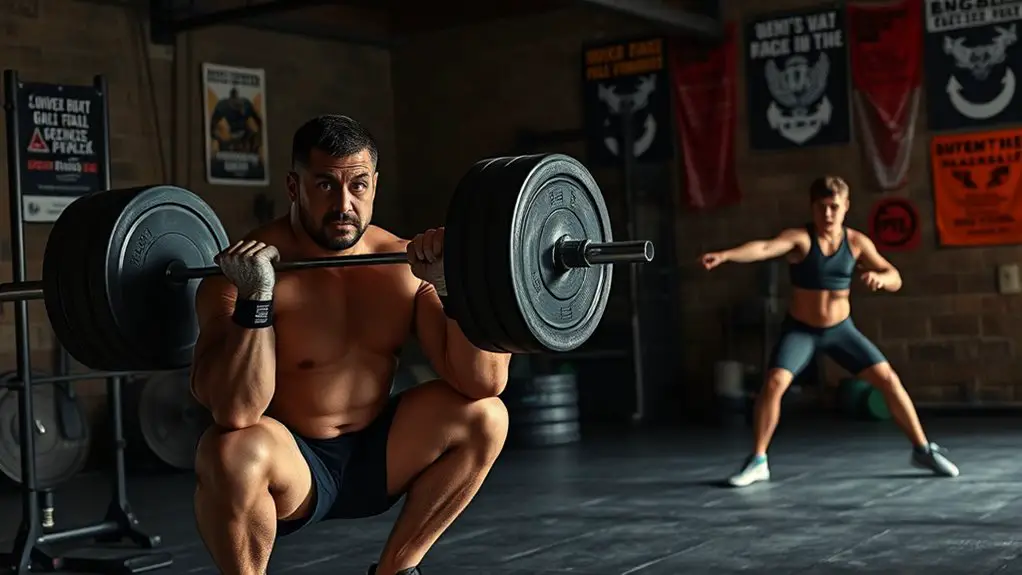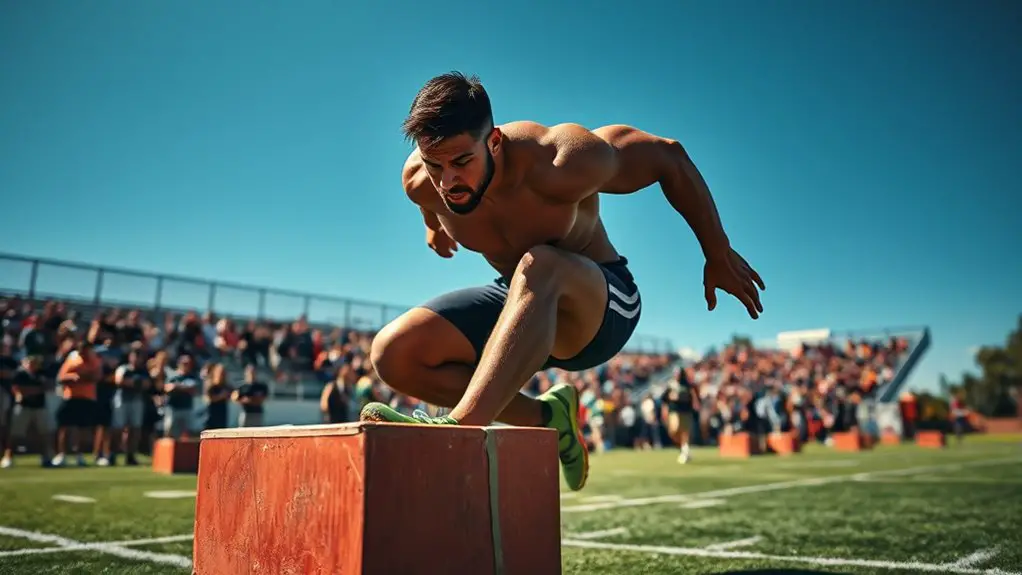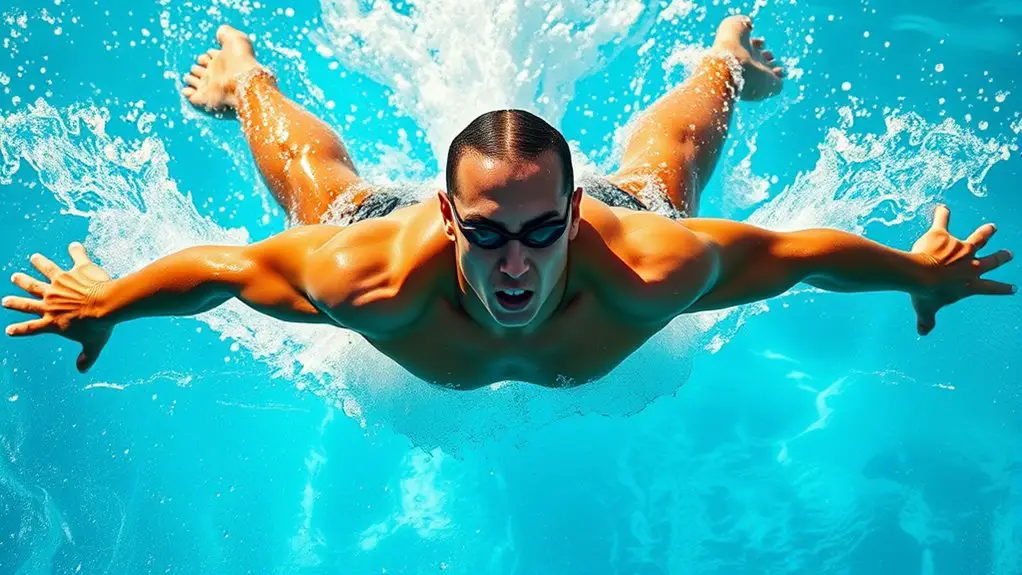To develop elite-level lateral quickness for tennis, focus on your footwork and agility with targeted drills. Start with dynamic warm-ups to improve mobility, then incorporate essential lateral quickness exercises like cone drills and shuffles. Plyometric training, such as lateral bounds and squat jumps, will boost your explosive movements. Don't forget to strengthen your core and lower body for better stability. With a consistent practice routine, you'll see significant improvements in your court coverage. Discover more strategies to enhance your game.
Understanding Lateral Quickness in Tennis
Lateral quickness is essential for tennis players, as it directly affects your ability to respond to opponents' shots. Mastering lateral movement is vital, allowing you to cover the court efficiently and stay in control during rallies. To improve your quickness mechanics, focus on how you position your body and shift weight effectively.
Start by practicing side-to-side drills that emphasize explosive movements. The more you train your body to react quickly, the more freedom you'll have on the court. Remember, it's not just about speed; it's about maintaining balance and agility while moving laterally. Incorporate agility training techniques such as lateral shuffles and cone drills to further enhance your performance on the court.
Incorporate resistance training and plyometrics into your routine to build strength and power in your legs, enhancing your lateral movement. By understanding the mechanics behind quickness, you'll gain an edge over your opponents, enabling you to dictate the pace and direction of the game. Embrace this journey, and you'll see your performance soar.
Importance of Footwork and Agility
Footwork and agility are the cornerstones of effective tennis play, allowing you to position yourself ideally for each shot. When you enhance your footwork, you gain the freedom to move fluidly across the court, making it easier to respond to your opponent's plays. This is where balance training comes into play; it helps you maintain stability while you dart left or right.
Improving your reaction time is also essential. The quicker you can respond, the more opportunities you have to swing confidently and dominate the rally. By focusing on agility drills, you'll notice how your overall performance improves, making you feel more in control of each point. Additionally, mastering proper foot placement can significantly aid in maintaining balance and stability during quick lateral movements.
Dynamic Warm-Up Exercises
Before hitting the court, incorporating dynamic warm-up exercises into your routine is essential for enhancing your lateral quickness. These exercises will not only improve your mobility but also prepare your body for the intense movements in tennis. Focus on dynamic stretching and mobility exercises to get those muscles ready. Additionally, engaging in exercises that promote core stability will further enhance your performance on the court.
Here's a quick reference table to help you get started:
| Exercise | Purpose |
|---|---|
| High Knees | Improves hip flexor mobility |
| Side Lunges | Enhances lateral movement |
| Arm Circles | Increases shoulder flexibility |
Essential Lateral Quickness Drills
Once you're warmed up and your muscles are primed, it's time to focus on drills that specifically enhance your lateral quickness. Start with lateral drills using agility cones. Set up a series of cones in a zigzag pattern, and practice side shuffles between them. This'll help you develop explosive lateral movements and improve your footwork.
Next, try the lateral box drill. Place four cones in a square and sprint to each cone while maintaining a low center of gravity. This drill trains your body to change direction quickly and efficiently.
Finally, incorporate the shuffle and jab drill. Shuffle laterally, then jab your foot to simulate a sudden stop. This mimics the unpredictable nature of tennis, enhancing your ability to react quickly. Additionally, incorporating cone drills into your training can further elevate your agility and overall performance on the court.
Incorporating Plyometric Training
To enhance your lateral quickness even further, incorporating plyometric training into your routine can be highly effective. Plyometric exercises focus on explosive movements, helping you develop the speed and agility needed on the tennis court. Think of drills like lateral bounds and squat jumps; they'll get your heart racing while building the muscle power essential for quick side-to-side motions.
By including these exercises, you'll train your muscles to react faster, improving your overall performance. Start with lower-intensity moves and gradually increase the intensity as you become more comfortable. Consistency is key—aim for two to three sessions per week dedicated to plyometrics. Plyometric training not only enhances fast-twitch muscle fibers but also boosts coordination and balance.
Remember to warm up properly to prevent injuries, and allow for recovery between sessions. Embrace the challenge, enjoy the freedom of movement, and watch how plyometric training elevates your game. Your lateral quickness will thank you!
Strengthening Core and Lower Body
A strong core and lower body are essential for achieving ideal lateral quickness in tennis. When you focus on core stability and lower body strength, you'll notice a significant improvement in your agility on the court. Here are some key components to work on:
- Core Stability: Engage in exercises like planks and Russian twists to build a solid foundation.
- Lower Body Strength: Incorporate squats, lunges, and deadlifts to enhance explosiveness and power.
- Balance Training: Use stability boards or perform single-leg exercises to improve your balance and coordination.
- Flexibility Exercises: Stretch regularly through yoga or dynamic stretching to maintain a full range of motion. Additionally, developing core strength is crucial for connecting the upper and lower body for efficient movement on the court.
Utilizing Resistance Training for Speed
While developing lateral quickness is essential for tennis, incorporating resistance training into your routine can greatly enhance your speed on the court. Using resistance bands is a fantastic way to build strength while improving your agility. Attach bands to your ankles and perform lateral shuffles; this'll help you develop explosive movements necessary for quick adjustments during a match. Additionally, resistance bands provide constant tension, ensuring that your muscles are engaged throughout the workout, which further enhances your overall strength and agility.
Additionally, agility hurdles are a game-changer for your training sessions. Set them up in a line and practice quick footwork drills, focusing on maintaining balance and speed. This not only strengthens your legs but also conditions your body to move efficiently in multiple directions.
Creating a Consistent Practice Routine
To improve your lateral quickness, you need a consistent practice routine. Start by setting specific goals that focus on your speed and agility. Then, schedule regular sessions and track your progress to guarantee you're staying on target. Incorporating reaction time drills into your routine will further enhance your agility and responsiveness on the court.
Set Specific Goals
Setting specific goals is essential for developing lateral quickness in tennis, as it provides a clear direction for your practice routine. By focusing on goal setting, you can enhance your performance measurement and track your progress effectively. Here are four steps to help you set those goals:
- Identify Key Skills: Pinpoint the lateral movements you want to improve.
- Set Measurable Targets: Define specific metrics, like time to complete a drill.
- Create Actionable Steps: Break down your goals into manageable tasks.
- Review and Adjust: Regularly evaluate your progress and tweak your goals as needed.
Schedule Regular Sessions
Establishing a consistent practice routine is essential for improving your lateral quickness in tennis, as it guarantees you dedicate time to develop the necessary skills. To maximize your progress, focus on ideal scheduling that fits into your lifestyle. Aim for a training frequency that keeps you engaged without burning out. Whether it's three days a week or daily sessions, consistency is key.
Try breaking your practice into focused segments, allowing your body to adapt and grow stronger. Don't hesitate to mix up your training methods; variety can keep things exciting and effective. By committing to regular sessions, you'll not only enhance your lateral quickness but also cultivate the freedom to explore your game more fully.
Track Progress Consistently
Tracking your progress consistently is essential for enhancing lateral quickness in tennis. By implementing effective progress tracking and performance metrics, you'll gain insights into your development. Here's how to keep yourself accountable:
- Set Specific Goals: Define what you want to achieve in your lateral movement.
- Use a Journal: Record your practice sessions and drill outcomes to visualize improvement.
- Measure Performance: Regularly assess your speed and agility with timed drills or fitness tests.
- Adjust Your Routine: Based on your metrics, tweak your practice sessions for better results.
Embrace this process, and you'll not only see improvements but also enjoy the freedom that comes with mastering your movement on the court.
Frequently Asked Questions
How Can Diet Impact My Lateral Quickness in Tennis?
Your diet plays an essential role in your lateral quickness. By focusing on nutrition timing, you can fuel your body before and after workouts, enhancing your performance. Incorporating carbs and protein at the right moments helps with recovery and energy levels. Plus, don't underestimate hydration strategies; staying well-hydrated keeps your muscles functioning effectively. When you nourish your body properly, you'll feel more agile and ready to move freely on the court.
What Role Does Mental Focus Play in Quick Lateral Movements?
They say, "Where the mind goes, the body follows." When it comes to quick lateral movements, your mental focus is essential. By practicing mental imagery, you can visualize the swift movements you want to execute, creating a powerful connection between your mind and body. Incorporating focus exercises into your training can sharpen your concentration, helping you react faster and move freely on the court. Embrace this mental aspect, and watch your agility soar!
How Can I Prevent Injuries While Training for Lateral Quickness?
To prevent injuries while training for lateral quickness, you've gotta prioritize injury prevention strategies. Start with proper warm-up routines to get your muscles ready for action. Incorporate dynamic stretches and mobility exercises that mimic lateral movements. Pay attention to your body and listen for any signs of strain. Gradually increase intensity and volume in your training, so you can achieve your goals without compromising your freedom to move fluidly and confidently.
Are There Specific Shoes That Enhance Lateral Quickness?
When it comes to improving your performance, you can't judge a book by its cover. Specific shoes designed with advanced shoe technology can really enhance your lateral quickness. Look for brands that prioritize stability and grip, like Nike or Asics. They often have features tailored for quick movements. Don't forget to check brand comparisons to find the perfect fit for your style. The right shoes can set you free on the court!
How Often Should I Assess My Progress in Lateral Quickness?
You should assess your progress in lateral quickness at regular intervals, like every two weeks or monthly. This way, you can track improvements and make necessary adjustments. Incorporate various assessment methods, like timed sprints or agility drills, to keep things interesting. By doing this, you'll not only stay motivated but also enjoy the freedom of seeing your enhancements over time. Remember, consistent evaluations help you reach your goals faster!
